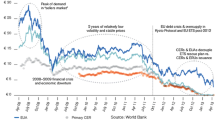Abstract
Emissions trading in climate change can entail large overall cost savings and transfers between developed and developing countries. However, the search for acceptable JI or CDM projects implies a deviation from the perfect market framework used in previous estimations. Our model combines the search market for projects with a frictionless permit market to quantify the supply-side frictions in the CO2 market. We also decompose the effects of frictions into the effects of search friction, bargaining, and bilateralism. A calibration using previous cost estimates of CO2 reductions illustrate changes in cost savings and allocative implications.
Similar content being viewed by others
References
Barrett, S. (1998), ‘Political Economy of the Kyoto Protocol’, Oxford Review of Economic Policy 14, 20–39.
Burdett, K. and K. Judd (1983), ‘Equilibrium Price Dispersion’, Econometrica 51, 955–970.
De Fraja, G. and J. Sákovics (2001), ‘Walras Retrouvé: Decentralized Trading Mechanisms and the Competitive Price’, Journal of Political Economy 109, 842–863.
Diamond, P.A. (1971), ‘A Model of Price Adjustment’, Journal of Economic Theory 3, 156–168.
Ellerman, D., P. Joskow, R. Schmalensee, J.-P.Montero and E. Bailey (2000), Markets for Clean Air, The U.S. Acid Rain Program. UK: Cambridge University Press.
Grubb M., C. Vrolijk and D. Brack (1999), The Kyoto Protocol: A Guide and Assessment. London: RIIA/Earthscan, Washington: Brookings.
Hagem, C. (1996), ‘Joint Implementation Under Asymmetric Information and Strategic Behavior’, Environmental and Resource Economics 8, 431–447.
Hahn, R. and R. Stavins (1999), ‘What Has Kyoto Wrought? The Real Architecture of International Tradeable Permit Markets’, Discussion Paper 99–30, Washington, Resources for the Future.
IPCC (1995), ‘Intergovernmental Panel on Climate Change, Climate Change 1995, Economic and Social Dimensions of Climate Change: Contribution of Working Group III to the Second Assessment Report of the Intergovernmental Panel on Climate Change’, in J. Bruce, H. Lee, and E. Haites, eds. Cambridge: Cambridge University Press.
Jepma, C. (2000), ‘Modernizing Heat Supply in Nizhny Novgorod’, Joint Implementation Quarterly 6(1), 9–10.
Jepma, C. (2000), ‘Planned and Ongoing AIJ Pilot Projects’, Joint Implementation Quarterly 6(4), 118.
Kiyotaki, N. and R. Wright (1991), ‘A Contribution to the Pure Theory of Money’, Journal of Economic Theory 53, 215–235.
Lile, M., R. Powell and R. Toman (1999), ‘Implementing the Clean Development Mechanism: Lessons from U.S. Private-Sector Participation in Activities Implemented Jointly’, Working Paper 99–08. Washington DC: Resources for the Future.
Liski, M. (2001), ‘Thin versus Thick CO2 Market’, Journal of Environmental Economics and Management 41, 295–311.
Liski, M. (2002), ‘Taxing Average Emissions to Overcome the Shutdown Problem’, Journal of Public Economics 85, 363–384.
Liski, M. (2002), ‘should Emissions Reduction Units Be Tradable?’, in The International Dimension of Environmental Policy. Kluwer.
Marin, D. and M. Schnitzer (1995), ‘Tying Trade Flows: A Theory of Countertrade with Evidence’, American Economic Review 85, 1047–1064.
Mortensen, D. and R. Wright (2002), ‘Competitive Pricing and Efficiency in Search Equilibrium’, International Economic Review 43, 1–20.
Nordhaus, W. (1991), ‘The Cost of Slowing Climate Change: A Survey’, The Energy Journal 12, 37–65.
Pissarides, C. A. (2000), Equilibrium Unemployment Theory. Cambridge, MA: MIT Press.
Schennach, S. (1998), ‘The Economics of Pollution Permit Banking in the Context of Title IV of the 1990 Clean Air Act Amendments’, Working Paper no. MIT-CEEPR 98–007 WP, Cambridge MA, MIT CEEPR.
Schmalensee, R. (1998), ‘Greenhouse Policy Architectures and Institutions’, in W. Nordhaus, ed., Economic Issues in Climate Change: Evaluations of the Intergovernmental Panel Report. Washington: Resources for the Future, pp. 137–158.
Spulber, D. (1996), ‘Market Making by Price Setting Firms’, Review of Economic Studies 63, 559–580.
Stavins, R. (1995), ‘Transaction Costs and Tradeable Permits’, Journal of Environmental Economics and Management 29, 133–148.
Stavins, R. (1998), ‘What Can We Learn from the Grand Policy Experiment? Lessons from SO2 Allowance Trading’, Journal of Economic Perspectives 12, 69–88.
Stavins, R. (2002), ‘Experience with Market-Based Environmental Policy Instruments’, in Handbook of Environmental Economics. Amsterdam: Elsevier Science.
Trejos, A. and R. Wright (1995), ‘Search, Bargaining, Money, and Prices’, Journal of Political Economy 103, 118–141.
Tulpulé, V., S. Brown, J. Lim, C. Polidano, H. Pant and B. Fisher (1999), ‘The Kyoto Protocol: An Economic Analysis Using GTEM’, The Energy Journal, Kyoto Special Issue, 257–285.
UNFCC (2001), ‘United Nations Framework Convention on Climate Change, Fifth Synthesis Report on Activities Implemented Jointly under the Pilot Phase’, SBSTA/2001/7.
Weyant, J. and P. Hill (1999), ‘Introduction and Overview’, The Energy Journal, Kyoto Special Issue, iv-xliv.
Wirl, F., C. Huber and I. Walker (1998), ‘Joint Implementation: Strategic Reactions and Possible Remedies’, Environmental and Resource Economics 12, 203–224.
Author information
Authors and Affiliations
Corresponding author
Rights and permissions
About this article
Cite this article
Liski, M., Virrankoski, J. Frictions in Project-Based Supply of Permits. Environmental and Resource Economics 28, 347–365 (2004). https://doi.org/10.1023/B:EARE.0000031060.86739.28
Issue Date:
DOI: https://doi.org/10.1023/B:EARE.0000031060.86739.28




